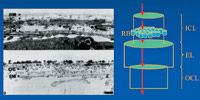Article
Diffusion through aging Bruch's membrane studied
Fort Lauderdale, FL-Studies evaluating age-related changes in the diffusional status of macromolecular transport processes across Bruch's membrane may provide new insight into the pathophysiology of age-related macular degeneration (AMD) and suggest new targets for intervention, said Ali A. Hussain, PhD, at the annual meeting of the Association for Research in Vision and Ophthalmology.

Dr. Hussain reviewed findings from studies examining the transportation pathway through Bruch's membrane, experiments assessing macromolecular diffusion rates, and the usefulness of pore theory in understanding the molecular mechanisms of the aging process. The research was performed at King's College, London, by Dr. Hussain, who is a senior scientist in the department of ophthalmology, and John Marshall, PhD, who is a professor of ophthalmology.

"When thin layers of the ICL were removed with the excimer laser, transport resistance through Bruch's membrane was unchanged. However, removal of the entire layer resulted in loss of all resistance through the system, and subsequent electron microscopy studies showed the resistance barrier lies in the ICL region in close proximity to the elastin layer of Bruch's membrane (Figure 1)," he explained.
Subsequent studies sought to analyze factors affecting the exclusion limits of Bruch's membrane, which provides a measure of pore radii and flux rates. Quantification of the rate of diffusion of dextrans of various molecular weights (4.4 to 150 kDa) showed there were no topographic- or age-related variations in exclusion limit. However, molecular transport measurements using a dextran smaller than the membrane's size exclusion limit showed a sharp, age-related decline in flux rate in the macular region and a significant, but more modest decrease in the periphery (Figure 2).
Newsletter
Don’t miss out—get Ophthalmology Times updates on the latest clinical advancements and expert interviews, straight to your inbox.




